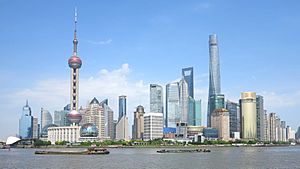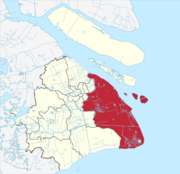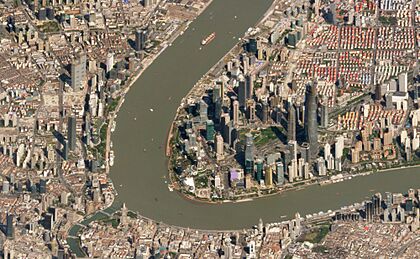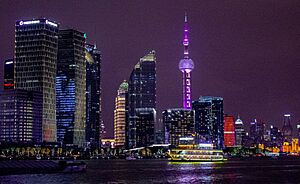Pudong facts for kids
Quick facts for kids
Pudong
浦东新区
|
|
|---|---|
|
District & State-level new area
|
|
| Pudong New Area | |

Lujiazui from the Bund
|
|

Location within Shanghai
|
|
| Country | People's Republic of China |
| Municipality | Shanghai |
| District Gov't Established | 1993 |
| Area | |
| • Total | 1,210.4 km2 (467.3 sq mi) |
| Population
(2020)
|
|
| • Total | 5,681,512 |
| • Density | 4,693.91/km2 (12,157.2/sq mi) |
| GDP | |
| • Total | CN¥ 1.6 trillion US$ 237.78 billion (2022) |
| • Per capita | CN¥ 281,180 US$ 41,755 (2022) |
| Time zone | UTC+08:00 (China Standard Time) |
| Postal code |
200120
|
| Area code(s) | 021 |
| Website | Pudong.gov.cn |
| Pudong | |||||||||||||
|---|---|---|---|---|---|---|---|---|---|---|---|---|---|

"Pudong" in Simplified (top) and Traditional (bottom) Chinese characters
|
|||||||||||||
| Simplified Chinese | 浦东 | ||||||||||||
| Traditional Chinese | 浦東 | ||||||||||||
| Postal | Pootung | ||||||||||||
| Literal meaning | "East of the Pu [River]" | ||||||||||||
|
|||||||||||||
Pudong is a very important district in Shanghai, a huge city in China. It is located on the east side of the Huangpu River, which flows right through the middle of Shanghai. The name Pudong means "East of the Pu River."
This area is famous for its amazing modern buildings and financial centers. You can find the Shanghai Stock Exchange here, along with famous skyscrapers like the Oriental Pearl Tower, the Jin Mao Tower, the Shanghai World Financial Center, and the Shanghai Tower. These tall buildings face the historic Bund on the west side of the river, which used to be a foreign settlement.
Pudong also has the Port of Shanghai, the Shanghai Expo Park, Century Park, Zhangjiang Hi-Tech Park, and the Shanghai Disney Resort. It's also home to the Shanghai Pudong International Airport.
Contents
History of Pudong
The name "Pudong" originally meant the land on the east side of the Huangpu River. This area was mostly farmland and developed slowly over time. Warehouses and docks were built near the river.
In 1990, the Chinese government decided to open up Pudong for major development. This was a big step to show that China was serious about its "Reform and Opening Up" policies.
In 1992, the original Pudong area joined with Chuansha County to form the Pudong New Area. In 1993, the government created a Special Economic Zone here. This meant Pudong had special rules to attract businesses and money from other countries. It was even more open than other special zones at the time.
The western part of Pudong became the Lujiazui Finance and Trade Zone. This area quickly grew into a major financial center for China. Many famous buildings were constructed here, including the Oriental Pearl Tower and three very tall skyscrapers: the Jin Mao Building, the Shanghai World Financial Center, and the Shanghai Tower. These buildings create the famous skyline you see in pictures of Shanghai.
In 2009, Nanhui District merged with Pudong, making the area even larger. In 2010, Pudong hosted the Shanghai Expo, a huge international event. The Expo grounds are now a public park.
How Pudong is Governed
Pudong is a district within Shanghai, which is a special "direct-controlled municipality" in China. This means Shanghai is managed directly by the central government.
The government of Pudong is very important, almost like a sub-provincial city. This is because Pudong is so large and important as a financial center. The top leader is the Pudong Communist Party Secretary, followed by the district governor.
Population and People
Pudong is bordered by the Huangpu River to the west and the East China Sea to the east. It's different from Puxi, which is the older part of Shanghai.
Pudong covers about 1,210 square kilometers (467 square miles). In 2020, its population was over 5.6 million people. This means about 22.8% of Shanghai's total population lives in Pudong. The population has grown a lot because many people move here for work and opportunities.
Most of the people in Pudong live in the northern part, which is more crowded. The southern part, which used to be Nanhui District, has fewer people.
Education in Pudong
Pudong has many schools and universities, from primary schools to higher education.
Universities and Colleges
- Shanghai Maritime University
- Shanghai Dianji University
- Shanghai Fisheries University
- China Executive Leadership Academy in Pudong
- Fudan University (in Zhangjiang)
- New York University Shanghai
- ShanghaiTech University
Schools for Kids and Teens
There are both public and international schools in Pudong.
Public Schools
- No. 2 High School Attached to East China Normal University
- Jianping High School
- Dongchang High School of ECNU
- Pudong Foreign Languages School of Shanghai International Studies University
- Shanghai Jincai Experimental Junior Middle School
International Schools
These schools teach students from many different countries.
- Dulwich College Shanghai
- French School of Shanghai Pudong Campus
- Nord Anglia International School Shanghai Pudong
- German School Shanghai Pudong Campus
- Shanghai American School Pudong Campus
- Shanghai Japanese School (SJS) Pudong Campus
- Wellington College International Shanghai
- Concordia International School Shanghai Pudong Campus
Other Private Schools
- Shanghai Gold Apple Bilingual School
- Shanghai Shangde Experimental School
- Shanghai Pinghe School
Pudong's Economy
Pudong has a very strong economy. In 2022, its total economic output was about 1.6 trillion Chinese Yuan (around 238 billion US dollars). Most of this comes from service industries. The average income per person in Pudong was about 281,180 Chinese Yuan (around 41,755 US dollars) in 2022.
The area has four main economic zones:
- Lujiazui Finance and Trade Zone: This is the main financial hub.
- Waigaoqiao Free Trade Zone: This is China's largest free trade zone, where goods can be imported and exported with fewer taxes.
- Jinqiao Export Processing Zone: A big area for factories and industrial businesses.
- Zhangjiang Hi-Tech Park: This zone focuses on technology and research companies.
Pudong is still growing very fast, especially in its business areas. Many new office buildings are being built. It also attracts a lot of investment in real estate.
The newest Disney resort in Shanghai, which includes Disneyland, opened in Pudong in June 2016.
Major Businesses in Pudong
Many big companies have their main offices in Pudong:
- Bao Steel
- Comac (an aircraft manufacturer)
- Yangtze River Express (a cargo airline)
- Hang Seng Bank (mainland China offices)
- Kroll (a global risk consulting firm)
- Google (Shanghai offices)
Getting Around Pudong
Pudong has a great transportation system, making it easy to travel.
Air Travel
The Shanghai Pudong International Airport opened in 1999. It's a major airport for people visiting Shanghai.
Metro and Maglev
The Shanghai Metro has many lines that go through Pudong, including Line 2, which connects to the airport. In 2004, a special magnetic levitation train started running. It carries passengers between the airport and Longyang Road Metro station very quickly.
Bridges and Tunnels
Pudong is connected to Puxi (the west side of Shanghai) by several bridges and tunnels across the Huangpu River.
- The first big bridges were the Nanpu Bridge (1991) and the Yangpu Bridge (1993).
- The Xupu Bridge opened in 1996.
- The Lupu Bridge, one of the world's longest arch bridges, was finished in 2002.
There are also five tunnels that link the two sides, making travel even easier.
Roads
Pudong has many important roads. Major roads like Pudong Avenue, Zhangyang Road, and Yanggao Road help people get around the district. Century Avenue is a main road that goes from Lujiazui to Century Park.
Climate in Pudong
Pudong has a humid subtropical climate. This means it has hot, humid summers and cool, dry winters. The average temperature for the whole year is about 17.1 degrees Celsius (62.8 degrees Fahrenheit).
The hottest month is usually July, with an average temperature of about 28.6 degrees Celsius (83.5 degrees Fahrenheit). The coldest month is January, with an average temperature of about 4.9 degrees Celsius (40.8 degrees Fahrenheit).
| Climate data for Pudong (1997–2020 normals, extremes 1981–2010) | |||||||||||||
|---|---|---|---|---|---|---|---|---|---|---|---|---|---|
| Month | Jan | Feb | Mar | Apr | May | Jun | Jul | Aug | Sep | Oct | Nov | Dec | Year |
| Record high °C (°F) | 21.5 (70.7) |
26.3 (79.3) |
29.0 (84.2) |
33.6 (92.5) |
33.3 (91.9) |
37.2 (99.0) |
40.0 (104.0) |
40.5 (104.9) |
36.5 (97.7) |
33.2 (91.8) |
29.2 (84.6) |
22.4 (72.3) |
40.5 (104.9) |
| Mean daily maximum °C (°F) | 8.9 (48.0) |
10.7 (51.3) |
15.1 (59.2) |
20.7 (69.3) |
25.4 (77.7) |
28.0 (82.4) |
32.8 (91.0) |
32.3 (90.1) |
28.4 (83.1) |
23.6 (74.5) |
18.1 (64.6) |
11.6 (52.9) |
21.3 (70.3) |
| Daily mean °C (°F) | 5.1 (41.2) |
6.7 (44.1) |
10.6 (51.1) |
15.9 (60.6) |
20.9 (69.6) |
24.2 (75.6) |
28.7 (83.7) |
28.5 (83.3) |
24.7 (76.5) |
19.7 (67.5) |
13.9 (57.0) |
7.6 (45.7) |
17.2 (63.0) |
| Mean daily minimum °C (°F) | 2.1 (35.8) |
3.4 (38.1) |
6.9 (44.4) |
11.8 (53.2) |
17.1 (62.8) |
21.2 (70.2) |
25.5 (77.9) |
25.6 (78.1) |
21.7 (71.1) |
16.2 (61.2) |
10.4 (50.7) |
4.3 (39.7) |
13.9 (56.9) |
| Record low °C (°F) | −6.5 (20.3) |
−4.4 (24.1) |
−2.3 (27.9) |
2.5 (36.5) |
9.1 (48.4) |
14.1 (57.4) |
19.9 (67.8) |
19.5 (67.1) |
13.4 (56.1) |
6.8 (44.2) |
0.6 (33.1) |
−4.5 (23.9) |
−6.5 (20.3) |
| Average precipitation mm (inches) | 77.2 (3.04) |
69.8 (2.75) |
85.1 (3.35) |
87.1 (3.43) |
91.1 (3.59) |
231.1 (9.10) |
154.2 (6.07) |
227.0 (8.94) |
136.3 (5.37) |
78.1 (3.07) |
70.4 (2.77) |
57.1 (2.25) |
1,364.5 (53.73) |
| Average precipitation days (≥ 0.1 mm) | 10.6 | 10.8 | 12.2 | 11.0 | 11.3 | 14.4 | 12.2 | 13.3 | 10.7 | 7.5 | 9.7 | 9.0 | 132.7 |
| Average snowy days | 2.0 | 1.7 | 0.6 | 0 | 0 | 0 | 0 | 0 | 0 | 0 | 0 | 0.8 | 5.1 |
| Average relative humidity (%) | 73 | 74 | 72 | 71 | 74 | 82 | 78 | 79 | 77 | 73 | 75 | 71 | 75 |
| Mean monthly sunshine hours | 107.1 | 111.1 | 147.0 | 168.4 | 173.1 | 120.0 | 189.8 | 191.4 | 156.8 | 152.3 | 122.7 | 123.4 | 1,763.1 |
| Percent possible sunshine | 33 | 35 | 39 | 43 | 41 | 28 | 44 | 47 | 43 | 44 | 39 | 40 | 40 |
| Source: China Meteorological Administration | |||||||||||||
Images for kids
-
Pudong at night with Oriental Pearl Tower
-
View of the Oriental Pearl Tower
Sister Cities
Pudong has "sister city" relationships with two places:
 Beverly Hills, California (USA)
Beverly Hills, California (USA) Kuopio (Finland)
Kuopio (Finland)
 In Spanish: Pudong para niños
In Spanish: Pudong para niños



















